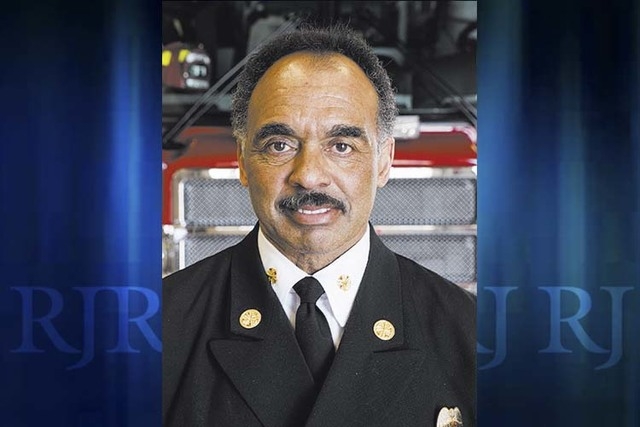Vegas, AMR pursuing ambulance transport deal
Las Vegas Fire Chief Willie McDonald and American Medical Response officials, after feuding since March over delivering patients to hospitals, have been working in tandem to reach a contract extension agreement acceptable to both the city and AMR.
If they agree on terms by the Wednesday meeting of the City Council, then a contract extension is likely to be approved by the council.
If they don’t agree, then McDonald is expected to continue pursuing an alternative that would mean the process to settle an exclusive franchise agreement would be opened for bids from other private ambulance companies. A number are eager to bid, according to Mayor Carolyn Goodman.
When the contract was discussed at the July 16 council meeting, McDonald said negotiations were progressing and he wasn’t ready to ask that the franchise be let out for a bid, even though that was the item on the agenda.
Before the meeting, McDonald’s position was that the 10-year-old contract which began Dec. 1, 2005, should be put out to bid.
Staff was recommending a request for proposal was the best way to handle a new ambulance franchise agreement. In a memo, staff took the position that “pre hospital care needs of our residents have evolved significantly (since 2005) and the implementation of the Affordable Care Act will influence the provision of services and create new opportunities and challenges.”
The staff memo for the agenda said a bidding process would be the “most objective” and “encourages creativity.”
“The competitive process will result in identifying the best qualified provider “and provide the greatest benefit to the city and residents,” the memo to the council declared. Since the change wouldn’t take place until December 2015, there would be time for a new company to be prepared
McDonald, however, said an agreement with AMR was close and he needed two more weeks before he would ask for a bidding process.
A representative from Henderson-based Community Ambulance urged the council to open the franchise agreement to a bid, but the council followed McDonald’s advice.
As of Friday, negotiations were still underway and the two sides had been in continual contact. McDonald said the city would return a draft document with comments and revisions to AMR for consideration by noon Monday.
Matthew Driscoll, spokesman for AMR, said the company was “very optimistic and the negotiations have been constructive and positive.”
City Councilman Bob Coffin said Friday he hasn’t been fully briefed on the ongoing negotiations but expects there will be a decision to split the transports 50-50. McDonald said previously his department can handle 50 percent of the transports without adding staff or equipment.
For the past 10 years, AMR has paid the city of Las Vegas nearly $400,000 annually for the right to be the exclusive private ambulance provider for the city.
But since 1999, the Fire Department has sought to increase the number of times it takes emergency patients to the hospital.
Money and jobs are at stake.
Las Vegas has a dual response system. When someone makes an emergency rescue call to 911, both the Fire Department and AMR respond. Whichever one takes the patient to the hospital gets to bill for the transportation service.
Starting in March, McDonald, who started as fire chief nearly one year ago, said the system would change.
Instead of the Fire Department transporting about 30 percent of the time when a hospital trip is required and AMR handling transports about 70 percent of the time, he wanted those numbers reversed.
By September 2015, McDonald’s goal is to have the Fire Department handle 75 percent of the transports.
He is phasing that in. Starting in March, the department tried to pick up half the daily calls before contacting AMR.
AMR General Manager Scott White challenged the change, questioning whether overly tired firefighters who work 24-hour shifts could be less alert than private ambulance paramedics and emergency medical technicians who work 12-hour shifts.
Another concern is whether firefighter/paramedics for the city, who are paid more than paramedics at AMR, will rack up overtime, pushing up both their income and their retirement benefits with the Public Employees Retirement System.
A third concern is whether firefighters handling a greater number of calls would be stuck waiting in emergency rooms and unable to respond to other calls.
McDonald said none of those concerns is valid.
The fire chief has a goal of flipping those numbers so that by September 2015, his department handles 75 percent of the transports and AMR handles 25 percent. The fire chief said his department can handle 50 percent of the calls without adding firefighter/paramedics and equipment.
In November 2012, a $155,000 International City County Management Association report on the Fire Department recommended that the city should either discontinue transports and save an estimated $14 million to $18 million a year in personnel and equipment, or bump up transports and see revenues increase between $12 million and $14 million.
McDonald and White have argued for more than three months whether the change improves public safety or harms it. Each side has challenged the accuracy of the other’s data.
On Wednesday, the council will learn if “let’s make a deal” succeeds.
Contact Jane Ann Morrison at jmorrison@reviewjournal.com or 702-383-0275. Find her on Twitter: @janeannmorrison.

















